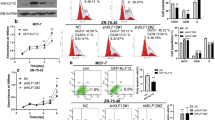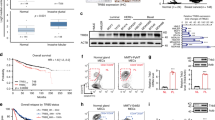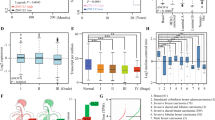Abstract
The Krüppel-like factor 5 (KLF5) is a zinc-finger transcription factor promoting cell proliferation, cell-cycle progression and survival. A high expression level of KLF5 mRNA has been shown to be associated with shorter breast cancer patient survival. However, the mechanism of KLF5 action in breast cancer is still not clear. In this study, we found that both KLF5 and its downstream gene fibroblast growth factor binding protein 1 (FGF-BP) are co-expressed in breast cell lines and primary tumors. Manipulation of the KLF5 expression can positively regulate the FGF-BP mRNA and protein levels in multiple breast cell lines. In addition, the secreted FGF-BP protein in the conditional medium is also regulated by KLF5. Furthermore, we demonstrated that KLF5 binds and activates the FGF-BP promoter through a GC box by luciferase reporter, oligo pull down and chromatin immunoprecipitation (ChIP) assays. When FGF-BP is depleted by siRNA, KLF5 fails to promote cell proliferation in MCF10A, SW527 and TSU-Pr1. We further demonstrated that overexpression or addition of FGF-BP rescues the KLF5-knockdown-induced growth arrest in MCF10A cells. Finally, KLF5 significantly promotes MCF7 breast cancer cell xenograft growth in athymic nude mice. These findings suggest that KLF5 may promote breast cancer cell proliferation at least partially through directly activating the FGF-BP mRNA transcription. Understanding the mechanism of KLF5 action in breast cancer may result in useful diagnostic and therapeutic targets.
This is a preview of subscription content, access via your institution
Access options
Subscribe to this journal
Receive 50 print issues and online access
$259.00 per year
only $5.18 per issue
Buy this article
- Purchase on Springer Link
- Instant access to full article PDF
Prices may be subject to local taxes which are calculated during checkout






Similar content being viewed by others
Abbreviations
- Ab:
-
antibody
- ChIP:
-
chromatin immunoprecipitation
- CM:
-
conditional media
- ER:
-
estrogen receptor
- FGF-BP:
-
fibroblast growth factor binding protein 1
- IHC:
-
immunohistochemistry
- KLF5:
-
Krüppel-like factor 5
- RT–PCR:
-
reverse transcript–PCR
- siRNA:
-
small interfering RNA
- wt:
-
wild type
- mt:
-
mutant
References
Abuharbeid S, Czubayko F, Aigner A . (2006). The fibroblast growth factor-binding protein FGF-BP. Int J Biochem Cell Biol 38: 1463–1468.
Aigner A, Butscheid M, Kunkel P, Krause E, Lamszus K, Wellstein A et al. (2001). An FGF-binding protein (FGF-BP) exerts its biological function by parallel paracrine stimulation of tumor cell and endothelial cell proliferation through FGF-2 release. Int J Cancer 92: 510–517.
Aizawa K, Suzuki T, Kada N, Ishihara A, Kawai-Kowase K, Matsumura T et al. (2004). Regulation of platelet-derived growth factor-A chain by Kruppel-like factor 5: new pathway of cooperative activation with nuclear factor-kappaB. J Biol Chem 279: 70–76.
Bateman NW, Tan D, Pestell RG, Black JD, Black AR . (2004). Intestinal tumor progression is associated with altered function of KLF5. J Biol Chem 279: 12093–12101.
Ben-Porath I, Thomson MW, Carey VJ, Ge R, Bell GW, Regev A et al. (2008). An embryonic stem cell-like gene expression signature in poorly differentiated aggressive human tumors. Nat Genet 40: 499–507.
Chanchevalap S, Nandan MO, McConnell BB, Charrier L, Merlin D, Katz JP et al. (2006). Kruppel-like factor 5 is an important mediator for lipopolysaccharide-induced proinflammatory response in intestinal epithelial cells. Nucleic Acids Res 34: 1216–1223.
Chen C, Benjamin MS, Sun X, Otto KB, Guo P, Dong XY et al. (2006). KLF5 promotes cell proliferation and tumorigenesis through gene regulation in the TSU-Pr1 human bladder cancer cell line. Int J Cancer 118: 1346–1355.
Chen C, Bhalala HV, Qiao H, Dong JT . (2002). A possible tumor suppressor role of the KLF5 transcription factor in human breast cancer. Oncogene 21: 6567–6572.
Chen C, Sun X, Guo P, Dong XY, Sethi P, Cheng X et al. (2005a). Human Kruppel-like factor 5 is a target of the E3 ubiquitin ligase WWP1 for proteolysis in epithelial cells. J Biol Chem 280: 41553–41561.
Chen C, Sun X, Guo P, Dong XY, Sethi P, Zhou W et al. (2007a). Ubiquitin E3 ligase WWP1 as an oncogenic factor in human prostate cancer. Oncogene 26: 2386–2394.
Chen C, Sun X, Ran Q, Wilkinson KD, Murphy TJ, Simons JW et al. (2005b). Ubiquitin-proteasome degradation of KLF5 transcription factor in cancer and untransformed epithelial cells. Oncogene 24: 3319–3327.
Chen C, Zhou Z, Ross JS, Zhou W, Dong JT . (2007b). The amplified WWP1 gene is a potential molecular target in breast cancer. Int J Cancer 121: 2834–2841.
Czubayko F, Liaudet-Coopman ED, Aigner A, Tuveson AT, Berchem GJ, Wellstein A . (1997). A secreted FGF-binding protein can serve as the angiogenic switch in human cancer. Nat Med 3: 1137–1140.
Czubayko F, Riegel AT, Wellstein A . (1994a). Ribozyme-targeting elucidates a direct role of pleiotrophin in tumor growth. J Biol Chem 269: 21358–21363.
Czubayko F, Smith RV, Chung HC, Wellstein A . (1994b). Tumor growth and angiogenesis induced by a secreted binding protein for fibroblast growth factors. J Biol Chem 269: 28243–28248.
Fujiu K, Manabe I, Ishihara A, Oishi Y, Iwata H, Nishimura G et al. (2005). Synthetic retinoid Am80 suppresses smooth muscle phenotypic modulation and in-stent neointima formation by inhibiting KLF5. Circ Res 97: 1132–1141.
Harris VK, Kagan BL, Ray R, Coticchia CM, Liaudet-Coopman ED, Wellstein A et al. (2001). Serum induction of the fibroblast growth factor-binding protein (FGF-BP) is mediated through ERK and p38 MAP kinase activation and C/EBP-regulated transcription. Oncogene 20: 1730–1738.
Harris VK, Liaudet-Coopman ED, Boyle BJ, Wellstein A, Riegel AT . (1998). Phorbol ester-induced transcription of a fibroblast growth factor-binding protein is modulated by a complex interplay of positive and negative regulatory promoter elements. J Biol Chem 273: 19130–19139.
Kagan BL, Henke RT, Cabal-Manzano R, Stoica GE, Nguyen Q, Wellstein A et al. (2003). Complex regulation of the fibroblast growth factor-binding protein in MDA- MB-468 breast cancer cells by CCAAT/enhancer-binding protein beta. Cancer Res 63: 1696–1705.
Kojima S, Kobayashi A, Gotoh O, Ohkuma Y, Fujii-Kuriyama Y, Sogawa K . (1997). Transcriptional activation domain of human BTEB2, a GC box-binding factor. J Biochem (Tokyo) 121: 389–396.
Kurtz A, Aigner A, Cabal-Manzano RH, Butler RE, Hood DR, Sessions RB et al. (2004). Differential regulation of a fibroblast growth factor-binding protein during skin carcinogenesis and wound healing. Neoplasia 6: 595–602.
Kurtz A, Wang HL, Darwiche N, Harris V, Wellstein A . (1997). Expression of a binding protein for FGF is associated with epithelial development and skin carcinogenesis. Oncogene 14: 2671–2681.
Kwak MK, Lee HJ, Hur K, Park do J, Lee HS, Kim WH et al. (2008). Expression of Kruppel-like factor 5 in human gastric carcinomas. J Cancer Res Clin Oncol 134: 163–167.
Li WM, Chen WB . (2004). Effect of FGF-BP on angiogenesis in squamous cell carcinoma. Chin Med J (Engl) 117: 621–623.
McConnell BB, Ghaleb AM, Nandan MO, Yang VW . (2007). The diverse functions of Kruppel-like factors 4 and 5 in epithelial biology and pathobiology. Bioessays 29: 549–557.
Mohsin SK, Weiss H, Havighurst T, Clark GM, Berardo M, Roanh le D et al. (2004). Progesterone receptor by immunohistochemistry and clinical outcome in breast cancer: a validation study. Mod Pathol 17: 1545–1554.
Oishi Y, Manabe I, Tobe K, Tsushima K, Shindo T, Fujiu K et al. (2005). Kruppel-like transcription factor KLF5 is a key regulator of adipocyte differentiation. Cell Metab 1: 27–39.
Ray PE, Tassi E, Liu XH, Wellstein A . (2006). Role of fibroblast growth factor-binding protein in the pathogenesis of HIV-associated hemolytic uremic syndrome. Am J Physiol Regul Integr Comp Physiol 290: R105–R113.
Ray R, Cabal-Manzano R, Moser AR, Waldman T, Zipper LM, Aigner A et al. (2003). Up-regulation of fibroblast growth factor-binding protein, by beta-catenin during colon carcinogenesis. Cancer Res 63: 8085–8089.
Santos-Rosa H, Schneider R, Bannister AJ, Sherriff J, Bernstein BE, Emre NC et al. (2002). Active genes are tri-methylated at K4 of histone H3. Nature 419: 407–411.
Shi H, Zhang Z, Wang X, Liu S, Teng CT . (1999). Isolation and characterization of a gene encoding human Kruppel-like factor 5 (IKLF): binding to the CAAT/GT box of the mouse lactoferrin gene promoter. Nucleic Acids Res 27: 4807–4815.
Shindo T, Manabe I, Fukushima Y, Tobe K, Aizawa K, Miyamoto S et al. (2002). Kruppel-like zinc-finger transcription factor KLF5/BTEB2 is a target for angiotensin II signaling and an essential regulator of cardiovascular remodeling. Nat Med 8: 856–863.
Sogawa K, Imataka H, Yamasaki Y, Kusume H, Abe H, Fujii-Kuriyama Y . (1993). cDNA cloning and transcriptional properties of a novel GC box-binding protein, BTEB2. Nucleic Acids Res 21: 1527–1532.
Sun R, Chen X, Yang VW . (2001). Intestinal-enriched Kruppel-like factor (Kruppel-like factor 5) is a positive regulator of cellular proliferation. J Biol Chem 276: 6897–6900.
Sur I, Rozell B, Jaks V, Bergstrom A, Toftgard R . (2006). Epidermal and craniofacial defects in mice overexpressing Klf5 in the basal layer of the epidermis. J Cell Sci 119: 3593–3601.
Sur I, Unden AB, Toftgard R . (2002). Human Kruppel-like factor5/KLF5: synergy with NF-kappaB/Rel factors and expression in human skin and hair follicles. Eur J Cell Biol 81: 323–334.
Tassi E, Henke RT, Bowden ET, Swift MR, Kodack DP, Kuo AH et al. (2006). Expression of a fibroblast growth factor-binding protein during the development of adenocarcinoma of the pancreas and colon. Cancer Res 66: 1191–1198.
Tong D, Czerwenka K, Heinze G, Ryffel M, Schuster E, Witt A et al. (2006). Expression of KLF5 is a prognostic factor for disease-free survival and overall survival in patients with breast cancer. Clin Cancer Res 12: 2442–2448.
Wan H, Luo F, Wert SE, Zhang L, Xu Y, Ikegami M et al. (2008). Kruppel-like factor 5 is required for perinatal lung morphogenesis and function. Development 135: 2563–2572.
Wang X, Zhao J . (2007). KLF8 transcription factor participates in oncogenic transformation. Oncogene 26: 456–461.
Wu DQ, Kan MK, Sato GH, Okamoto T, Sato JD . (1991). Characterization and molecular cloning of a putative binding protein for heparin-binding growth factors. J Biol Chem 266: 16778–16785.
Yang Y, Goldstein BG, Chao HH, Katz JP . (2005). KLF4 and KLF5 regulate proliferation, apoptosis and invasion in esophageal cancer cells. Cancer Biol Ther 4: 1216–1221.
Yang Y, Goldstein BG, Nakagawa H, Katz JP . (2006). Kruppel-like factor 5 activates MEK/ERK signaling via EGFR in primary squamous epithelial cells. FASEB J 21: 543–550.
Zhang Z, Teng CT . (2003). Phosphorylation of Kruppel-like factor 5 (KLF5/IKLF) at the CBP interaction region enhances its transactivation function. Nucleic Acids Res 31: 2196–2208.
Zhao Y, Hamza MS, Leong HS, Lim CB, Pan YF, Cheung E et al. (2008). Kruppel-like factor 5 modulates p53-independent apoptosis through Pim1 survival kinase in cancer cells. Oncogene 27: 1–8.
Acknowledgements
This work was supported in part by a grant (BCTR0503705) from the Susan G Komen Breast Cancer Foundation, a grant from the American Cancer Society and a grant from the Department of Defense (W81XWH-07-1-0191). We thank Dr Chunhong Yan and Dr Jihe Zhao for providing the pRL-β-actin construct and the pBabe-puro retroviral system.
Author information
Authors and Affiliations
Corresponding author
Rights and permissions
About this article
Cite this article
Zheng, HQ., Zhou, Z., Huang, J. et al. Krüppel-like factor 5 promotes breast cell proliferation partially through upregulating the transcription of fibroblast growth factor binding protein 1. Oncogene 28, 3702–3713 (2009). https://doi.org/10.1038/onc.2009.235
Received:
Revised:
Accepted:
Published:
Issue Date:
DOI: https://doi.org/10.1038/onc.2009.235
Keywords
This article is cited by
-
The FUS/circEZH2/KLF5/ feedback loop contributes to CXCR4-induced liver metastasis of breast cancer by enhancing epithelial-mesenchymal transition
Molecular Cancer (2022)
-
YB-1 is a positive regulator of KLF5 transcription factor in basal-like breast cancer
Cell Death & Differentiation (2022)
-
Poly-L-arginine promotes asthma angiogenesis through induction of FGFBP1 in airway epithelial cells via activation of the mTORC1-STAT3 pathway
Cell Death & Disease (2021)
-
A novel Schiff base cobalt(III) complex induces a synergistic effect on cervical cancer cells by arresting early apoptosis stage
BioMetals (2021)
-
Mithramycin A suppresses basal triple-negative breast cancer cell survival partially via down-regulating Krüppel-like factor 5 transcription by Sp1
Scientific Reports (2018)



